Water pressure in the water supply: what should it be and how to increase it if necessary
For the smooth functioning of plumbing fixtures, it is necessary that the water pressure in the water supply corresponds to a certain indicator, which is usually calculated individually.
But correct calculations do not guarantee that in practice the water pressure will be optimal. Owners of country houses most often face the problem of low water pressure in pipes. It can be solved by introducing equipment.
We propose to understand what the pressure standards are in the water supply of a private house and for what reasons the pressure decreases. We will offer effective methods for increasing the efficiency of water supply. We have supplemented the material with detailed photo instructions and videos.
The content of the article:
Pipeline pressure standards
Water pressure is measured in bars. The quantity has an alternative name - atmospheric unit. Under a pressure of 1 bar, water can rise to a height of 10 m.
IN city networks Usually the pressure is 4-4.5 bar, which is enough to service multi-storey buildings.
According to regulatory documents, in particular the instructions of the SNiP 2.0401-85 collection, the permissible pressure for cold water varies from 0.3 to 6 bar, for hot water - from 0.3 to 4.5. But this does not mean that a pressure of 0.3 atmospheres will be optimal. Only permissible pressure limits are given here.
Residents of private houses are forced to calculate the pressure in the water supply individually. If the system is autonomous, the pressure may exceed the limits allowed by regulatory documents. It can fluctuate around 2.5-7.5 bar, and sometimes reach 10 bar.
Standard values for normal system operation with pumping station The interval is considered to be 1.4 - 2.8 bar, corresponding to the factory setting of the pressure switch indicators.
If you provide excessively high pressure in the system, some sensitive devices may fail or operate incorrectly. Therefore, the pressure in the pipeline should not exceed 6.5 bar.
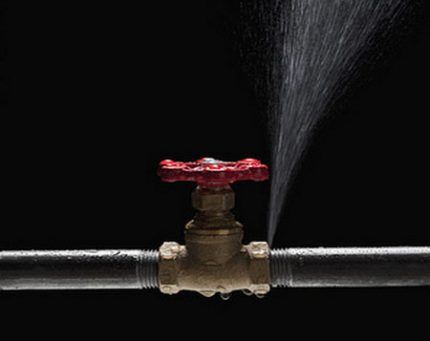
Flowing artesian wells are capable of delivering a pressure of 10 bar. Only welded joints can withstand such pressure, but most fittings and shut-off and control units are destroyed under its influence, resulting in leaks in areas.
It is necessary to determine what water pressure is necessary for the normal functionality of the water supply system of a country house, taking into account the household appliances used. Some types of plumbing fixtures do not work at low pressure.
For example, a jacuzzi requires a pressure of 4 bar, a shower and fire extinguishing system require 1.5 bar, and a washing machine requires 2 bar. If you provide for the possibility of watering the lawn, then there should be a strong pressure of 4, sometimes 6 bar.

The optimal pressure indicator for a country house will be 4 bar. This pressure is enough for the proper operation of all plumbing fixtures. At the same time, most fittings and shut-off and control valve units are capable of withstanding it.
Not every system can provide a pressure of 4 bar.Typically, for country houses, the pressure in the water supply is 1-1.5 bar, which corresponds to gravity.
Reasons for low pressure in water supply
In country houses, water in the water supply network comes from wells or wells.
If the system is completely autonomous, then to create the required pressure you need to take into account two points:
- the need to ensure water rise;
- It is important to carry out a correct hydraulic calculation and implement it correctly in practice - to ensure the necessary pressure at points remote from the catchment area and at points located at different heights.
This leads to two main problems of individual water supply systems:
- Not enough well resources — the flow rate of the hole does not allow maintaining normal pressure, and, therefore, increasing the pressure.
- There is a lot of water in the well, therefore, pumps can pump high pressure (up to 6 bar), which can lead to broken connections, leaks, and rapid wear of equipment.
In the first case, pumps pump liquid, creating its circulation until a certain pressure arises, but over time it weakens. In the second case, you need to select a pump with a capacity that is equal to the daily water consumption.
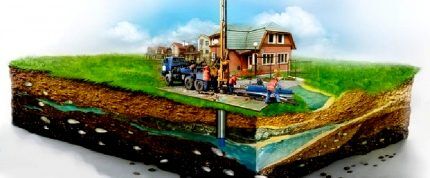
However, most owners of private houses are concerned with the question of how to competently increase the pressure in their own water supply, and not lower it, because only some artesian wells have the necessary flow rate to create high pressure.
Most of the holes generate weak water pressure, or even are not able to produce any pressure at all.
If standard household appliances are used in the house, then it is enough to raise the pressure to 2.3-2.5 bar - this wave will be enough for their uninterrupted simultaneous functioning with good pressure. If a Jacuzzi or irrigation system is provided, then higher pressure is required.
A pressure gauge is used to measure pressure. It is purchased separately and installed at the water entry point into the house. A water meter is also installed there. Some equipment comes complete with a pressure gauge. For example, a heating boiler, if FGP is provided.
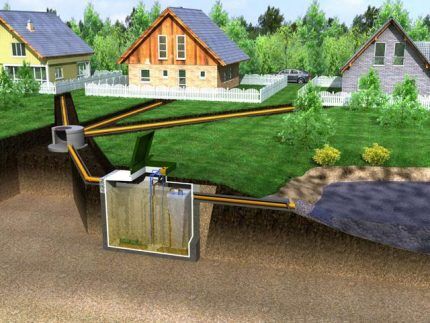
A simple pressure gauge has a scale from 0 to 7, which allows it to be installed in an apartment or private house.
Methods for increasing system pressure
If the pressure in the water supply is low, the reason may be the following:
- There is water in the pipeline, but there is no pressure.
- There is no water in the pipeline on the upper floors.
To solve the first problem it is necessary to implement into the system pressure booster pump, to solve the second - install a storage station.
Before introducing technical means into the water supply system, you should first check the network for clogging:
#1: Implementation of a pressure booster pump
If there is water in the pipeline, but there is no pressure, then install a pressure pump. The device can also be installed if there is no pressure in an apartment with central heating.
The reason for the lack of pressure may be the following:
- the well is located remotely at home;
- The power of the base pump is not enough to supply water to the upper floors.
The pump is usually installed at the entrance to the home piping network before the manifold or first tee.
There is one drawback of central pumps - they create a vacuum, that is, they can pump water saturated with air. A conventional centrifugal injection pump is sensitive to the air content in the liquid, so it is worth giving preference to vibration modifications.
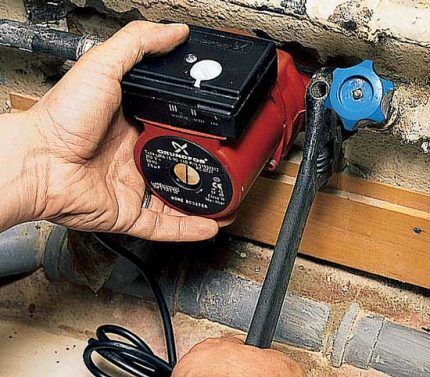
To install the device in an apartment building, it is important to choose the correct power modification, otherwise the owner of the “pumped” water supply will reduce the pressure in neighboring apartments. It is recommended to install the pump on a pipe leading to a specific household appliance.
In the general case, the pump is embedded into a common pipe, which is responsible for supplying water to an apartment or house.The device itself is quite compact and inexpensive.
#2: Main types of injection pumps
There are models with dry and wet rotor (flow-through). The elements of a glandless rotor pump are lubricated by the passing fluid. Devices of this class do not require additional maintenance if they are initially connected correctly.
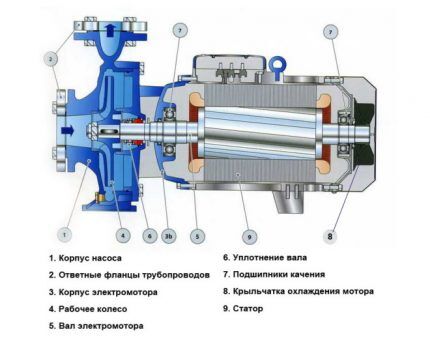
A pump with a dry rotor has good power, but it requires regular maintenance and produces quiet sounds during operation, reminiscent of the squeak of a mosquito. Its parts are protected by a waterproof flap, so you will have to clean the device once a month.
Based on the type of operation, pumps are divided into the following types:
- manual pressure booster pump and has manual control. The model works constantly and does not have automatic switches.The device has a simple design that is understandable for ordinary people; Most often the device is used in “warm floor” systems;
- automatic pump – starts only when the tap or household appliances are turned on. After they are closed it turns off.
An automatic pump is more expensive than a manual one, consumes little energy, quickly responds to changes in pressure and is the most popular today.
Selecting a pressure pump is quite simple.
It is important to determine the following:
- the device will be installed for hot or cold water;
- required pressure level - the higher the indicator, the greater the pressure in the system will be.
Accordingly, the higher the pressure, the more power and throughput of the equipment is needed.
It is equally important to choose a pressure pump taking into account the brand, since in the event of a breakdown, not every repair service will undertake to fix a model produced by an unknown company. The most famous and universally recognized manufacturers - Grundfos, Wilo, Sprut. Each company specializes in producing different modifications of the device.
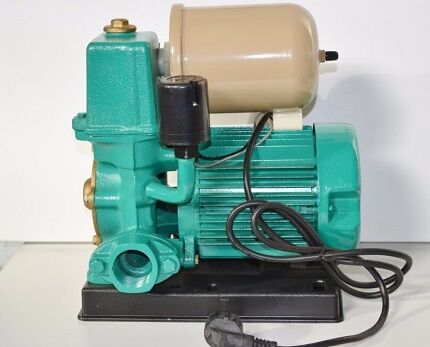
For example, Grundfos produces small-volume circulation pumps, Wilo They are developing models with a built-in hydraulic accumulator.
To connect the circulation pump you need:
- Shut off the water in the area.
- Release water from the pipeline and the system as a whole.
- Cut off the part of the pipe in which the installation will be carried out.
- Attach fittings and nozzles to the joints.
- Plug the equipment into the water supply.
It is also permissible to use a polypropylene or rubber hose to simplify installation. In modern circulation pumps, such pipes are included.
#3: Increasing pressure with a storage tank
When the pipelines in the house are without water or if there is water on the lower floor but does not reach the upper floors, it is necessary to purchase a storage pumping station. It is also introduced into the system when the network pressure is less than 0.2 bar and the flow rate is less than 2 l/m.

The principle of its operation is as follows. The pump pumps liquid into the station (tank or accumulator), which operates under a pressure of 1.5-2 bar. Water flows until a pressure of 1.5 or 2 bar appears in the tank. If the station is equipped hydraulic accumulator, then the pressure created can be an order of magnitude higher.
After generating the required pressure, the pumping station turns off automatically.
Special pressure sensors were introduced into the design of the storage station. When the pressure drops to 1.5 bar, the main pump turns on, and when it increases to a certain point, it turns off.
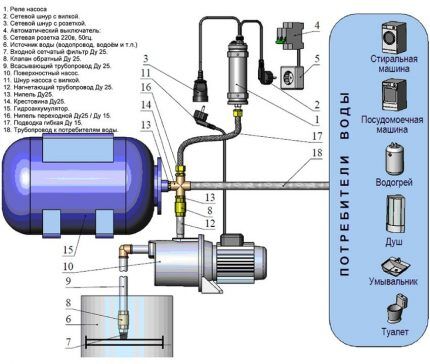
The pump in the station can be one of two types - centrifugal or vibration.
According to the type of suction they are distinguished:
- designs with a removable ejector – capable of generating a pressure of 5 bar. The ejector is immersed in a well, and the tank itself can be located at home, since it makes virtually no noise during operation.The station is mainly used in cases where the water source is located deep, and its disadvantage is sensitivity to mechanical elements - sand, dirt, etc.
- equipment with built-in ejector – suitable for shallow (up to 8 meters) wells and wells, works effectively in dirty water, is not sensitive to air ingress, but has a high noise level, so it is usually installed in special outbuildings.
Models with a storage tank are economical (they start when the tank is empty), but have many disadvantages: they generate low pressure, have large dimensions, and there is a possibility of rupture, which can result in flooding of the room.
Stations with a storage tank are practically not used today. They were replaced by models with a hydraulic accumulator. They are small in size and do not make noise during operation.
The device can be installed in a basement, utility room, or separate extension. This minimizes the risk of leaks. But the hydraulic accumulator has a small reserve capacity (about 25 liters) and is not used for wells with low flow rates.
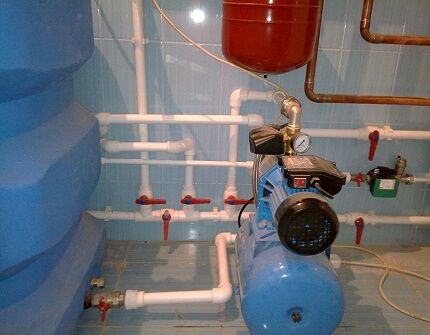
Stations are also divided into surface (when the pump is located on the ground) and submersible (the device is immersed in water), the latter are conventionally divided into well and borehole.
To increase the level of water pressure in the apartment pipeline, pumping stations are not used due to the design features and noise during operation.
Despite its impressive cost, the pumping station has a number of undeniable advantages:
- it is possible to set any desired pressure in the house, which will allow the use of any plumbing fixtures, including those that require high pressure to function;
- the water supply will be uninterrupted even if it is not in the central line (due to the presence of a storage tank).
The system has some disadvantages: it is bulky and takes up a lot of space.
It is important to correctly determine the volume of storage capacity. This value is taken taking into account the average daily water consumption rate. If a family consists of 3-4 people, then approximately 500 liters of water per day will be enough.
When making calculations, it is also important to take into account that the water needs to be updated from time to time to avoid the appearance of bacteria.
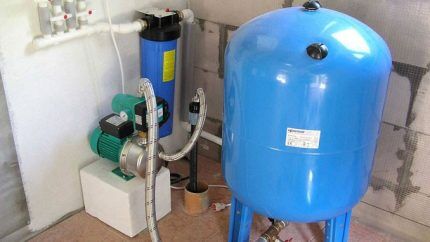
It is important to clean the storage container promptly and regularly, since pathogenic bacteria accumulate in it. Small bags of technical silver placed inside the tank prevent their reproduction.
It should be remembered that there should be no shut-off valves on the overflow pipe. If the float valve fails, water will drain through it.
It is also necessary to install a bypass so that in the event of a station failure it is possible to turn off the system without completely shutting off the water supply.
Conclusions and useful video on the topic
Video No. 1. How to choose an electrical station. In the video you can learn about the features of choosing an electric station with a hydraulic accumulator:
Video No. 2. The video describes the main points when installing a pressure pump:
As you can see, it is not difficult to increase the pressure in the water supply. To solve the problem, a pressure pump or a special pumping station is used. If it is possible to install the pump yourself, then you should entrust the installation of the station to professionals.
Do you have personal experience in improving water pressure? Do you want to share effective methods or ask questions on the topic? Please leave comments - the feedback form is located below.




There was such a problem when I built a second floor on the dacha and made a bathroom there too. The water did not want to rise to the required height. We had to partially redo the water supply system and install a more powerful pump with a storage tank. Now there is constant water on the second floor. True, electricity consumption has increased due to the powerful pump.
From my own experience, I can say that first you need to correctly determine the depth of the aquifer during construction. Professionals check the pressure, pressure as well as the quality of the water. They can spend a lot of time catching the right depth. For example, for me, even a little, about half a meter, then they pulled out the pipe after drilling, which ultimately gave an excellent result. Well, and of course, you need to install a good pumping station; there is a very large choice now.
Good afternoon I need advice: is it possible to separately install a cold water supply pipe into an apartment on the 5th floor of a 5-story building, running parallel to the common riser for the remaining 4 floors? The reason is water intake on the lower floors. Is this legal and won’t everyone’s blood pressure drop after such a maneuver? Thanks in advance to everyone!
It is not very clear what to do for those who have a centralized water supply, but there are many consumers on the line and the pressure in the system very often drops.